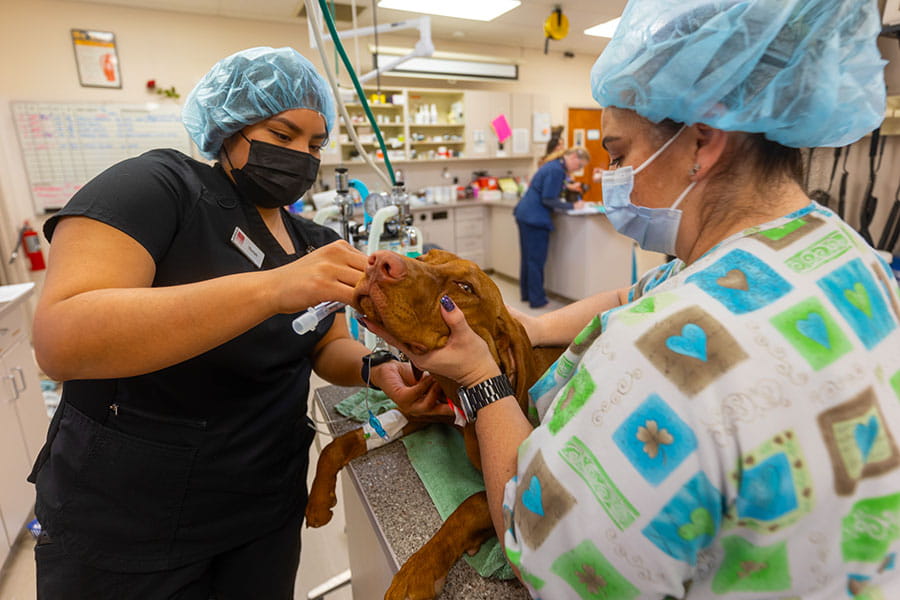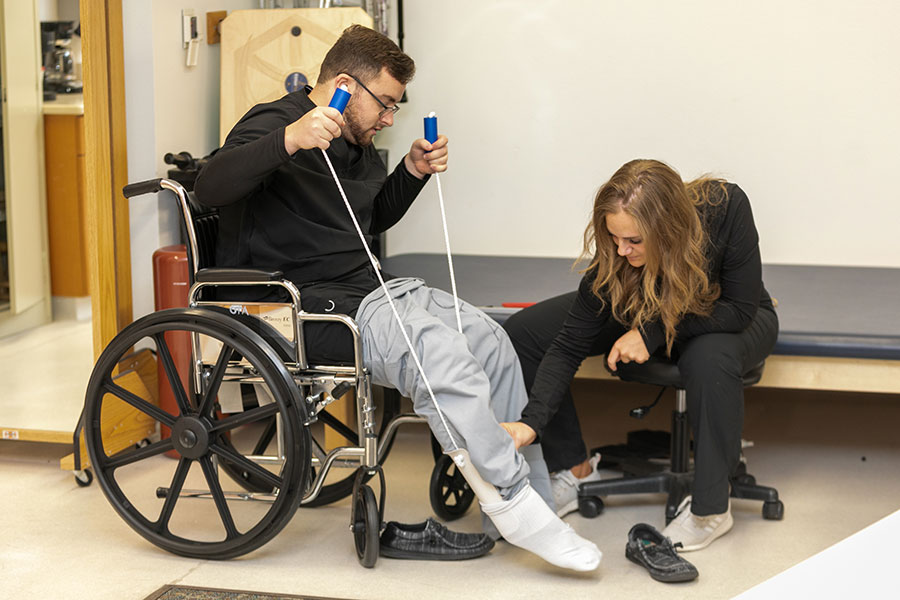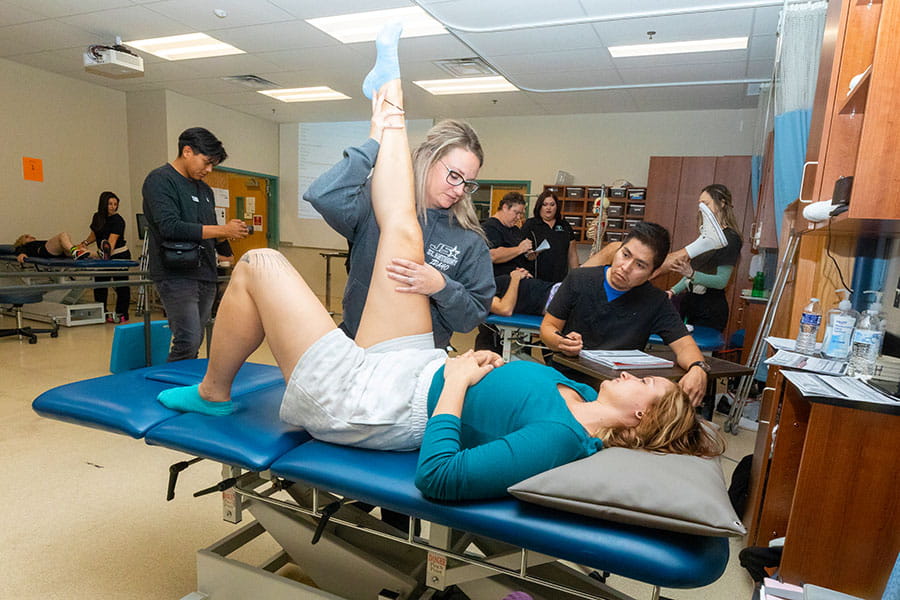Upper Tier Clinical Task Requirements
Required Clinical Tasks Listed by Course
Click on the course name to view the required clinical tasks for that course.
San Juan College
Veterinary Technology Distance Learning Program (VTDLP)
Required Clinical Tasks
Below a list of the clinical tasks required in each of the VETT courses. Once a student enrolls in one of the courses, they will receive a document with detailed step-by-step instructions for each task. (Note: The tasks and instructions are subject to change based on updates made by the CVTEA and VTDLP.)
The San Juan College Veterinary Technology Distance Learning Program (VTDLP) is fully accredited by the American Veterinary Medical Association’s Committee on Veterinary Technician Education & Activities (AVMA-CVTEA), which is the accrediting body for all veterinary technology programs. The AVMA website states:
Accreditation by the AVMA Committee on Veterinary Technician Education and Activities (CVTEA) represents the highest standard of achievement for veterinary medical education in the United States. Institutions that earn accreditation confirm their commitment to quality and continuous improvement through a rigorous and comprehensive peer review.
Within veterinary medicine, the AVMA – CVTEA develops standards and reviews programs in veterinary technology. An institution or program is considered fully accredited when it is found to meet these standards (see the CVTEA accreditation process and Accreditation Policies and Procedures for more information).
Graduation from an AVMA-CVTEA-accredited institution is a prerequisite for licensure or certification for professional practice through the majority of state licensing boards and credentialing agencies in order to meet the educational prerequisites. (AVMA 2018)*
The AVMA-CVTEA mandates that all students graduating from accredited programs be able to perform certain clinical tasks. (See CVTEA’s Essential and Recommended Skills List) To meet these requirements, several courses in the VTDLP have Course Task Checklists (CTCs) that contain these clinical tasks. While the didactic information for these procedures is covered in the courses, students must perform the tasks in the CTCs in their approved OCCI clinical sites and be evaluated by their preceptors.
Near the end of the program, students must then film themselves performing these same small animal procedures (dogs & cats) and be evaluated by VTDLP Instructors in the Video Portfolio Courses.
- VETT 219 Veterinary Nursing I
- VETT 221 Anesthesia & Surgical Assisting
- VETT 222 Clinical Pathology
- VETT 223 Veterinary Nursing II
To satisfy the program requirements for the large animal (horses/cattle) and laboratory & exotic animal tasks (mice, rats, rabbits, Guinea Pigs, Avian species), students may either submit a video or attend the Fast Track Lab (FTL) offered in Waco Texas each semester. For the FTL option, no large animal/lab animal video is required, making FTL the most popular option with students. (FTL-General Information and Overview). The clinical tasks for these species are covered in:
- VETT 233 Large Animal Clinical Assisting
- VETT 235 Laboratory Animal & Small Exotic Clinical Procedures
*AVMA. (2018, July 01). AVMA Center for Veterinary Education Accreditation. Retrieved from AVMA Our Passion. Our Profession.: https://www.avma.org/ProfessionalDevelopment/Education/Accreditation/Pages/default.aspx
Clinical Tasks: Course Task Checklist
- Cage/Kennel: Place a Dog in a Cage or Kennel
- Cage/Kennel: Remove a Dog from a Cage or Kennel
- Cage/Carrier: Place a Cat in a Cage or Carrier
- Cage/Carrier: Remove a Cat from a Cage or Carrier
- Restraint: Standing – Dog
- Restraint: Sitting – Dog
- Restraint: Sternal Recumbency – Dog
- Restraint: Lateral Recumbency – Dog
- Restraint: Dorsal Recumbency – Dog
- Restraint: Cephalic Venipuncture – Dog or Cat
- Restraint: Saphenous Venipuncture – Dog or Cat
- Restraint: Jugular Venipuncture – Dog or Cat
- Restraint: Restraint Pole – Dog**
- Apply a Gauze Muzzle: Dog
- Apply a Nylon or Leather Muzzle: Dog
- Apply Elizabethan Collar: Dog or Cat
- Patient History: Dog or Cat
- Physical Exam: Dog
- Obtain Vital Signs: Cat
- ECG
- Venipuncture: Cephalic – Dog
- Venipuncture: Cephalic – Cat
- Collect Voided Urine Sample: Dog
- Cystocentesis: Female Dog**
- Urinary Catheter: Male Dog**
- Urinary Catheter: Male Cat (Sim. Only)**
- Express Canine Anal Sacs
- Liquid Administration: Dog and Cat
- Hand Pilling: Dog
- Hand Pilling: Cat
- Orogastric Intubation: Dog**
- Enema**
- Subcutaneous Injection: Dog
- Subcutaneous Fluids: Dog or Cat
- Intravenous Catheter: Cephalic Vein
** Simulations available
Clinical Tasks: Course Task Checklist
- Cage/Kennel: Place a Dog in a Cage or Kennel
- Cage/Kennel: Remove a Dog from a Cage or Kennel
- Cage/Carrier: Place a Cat in a Cage or Carrier
- Cage/Carrier: Remove a Cat from a Cage or Carrier
- Restraint: Standing – Dog
- Restraint: Sitting – Dog
- Restraint: Sternal Recumbency – Dog
- Restraint: Lateral Recumbency – Dog
- Restraint: Dorsal Recumbency – Dog
- Restraint: Cephalic Venipuncture – Dog or Cat
- Restraint: Saphenous Venipuncture – Dog or Cat
- Restraint: Jugular Venipuncture – Dog or Cat
- Apply a Gauze Muzzle: Dog
- Apply a Nylon or Leather Muzzle: Dog
- Apply Elizabethan Collar: Dog or Cat
- Trim Nails: Dog
- Trim Nails: Cat
- Clean and Medicate Ears: Dog
- Clean and Medicate Ears: Cat
- Liquid Administration: Dog & Cat
- Hand Pilling: Dog
- Hand Pilling: Cat
- Subcutaneous Injection: Dog
- Schirmer Tear Test
- Topical Medications: Eye Drops
- Fluorescein Stain Test
- Tonometry (Tonopen or TonoVet)
- Topical Medications: Ophthalmic Ointment
Clinical Tasks: Course Task Checklist
- Medication Labeling
- Fill an Oral Solid Medication
- Fill a Liquid Medication
- Reconstitute a Medication for Dispensing
- Reconstitute a Vaccine
- Dispense Medication to a Client
- Controlled Substance Protocols and Handling
- Inventory Procedures
Clinical Tasks: Course Task Checklist
- Maintain and Operate an Anesthetic Machine
- Perform Pressure-Checking an Anesthetic Machine for Leaks
- Perform Preparation of a Surgical Gown for Sterilization
- Perform Cleaning and Sterilization of the Surgical Room
- Perform Cleaning Surgical Instruments
- Perform Preparation of a Sterile Pack
- Perform Sterilizing packs in an Autoclave
- Complete a Controlled Substance Log
- Operate Anesthetic Monitoring Equipment: Esophageal Stethoscope
- Operate Anesthetic Monitoring Equipment: Blood Pressure Monitor
- Operate Anesthetic Monitoring Equipment: Capnometer
- Operate Anesthetic Monitoring Equipment: Electrocardiogram
- Operate Anesthetic Monitoring Equipment: Pulse Oximeter
Clinical Tasks: Course Task Checklist
- Clinical Tasks: Course Task Checklist
- Radiation Safety Training Presentation
- Labeling and Identification of Radiographic Film
- Patient Safety and Caliper Use
- Radiographic Patient Positioning: Forelimb
- Radiographic Patient Positioning: Hindlimb
- Radiographic Patient Positioning: Skull and Spine
- Radiographic Patient Positioning: Thorax and Abdomen
- Radiology Log
Clinical Tasks: Course Task Checklist
- Microscope Operating Procedures
- Centrifuge
- Refractometer
- Hematology Analyzer
- Packed Cell Volume & Hemoglobin
- Total Protein
- Prepare Blood Film & Stain
- Evaluate Erythrocyte Morphology
- Calculate Hematologic Indices
- Perform Manual Leukocyte Differential
- Calculate Absolute Values
- Correct WBC Counts for Nucleated Cells
- Estimate Platelet Numbers
- Coagulation Tests: Buccal Mucosal Bleeding Time
- Prepare Serum & Plasma
- Blood Chemistry & Electrolyte Panel: BUN, Glucose, Common Enzymes
- Serologic Test: ELISA
- Identify Blood Parasites: Dirofilaria sp / Acanthocheilonema
- Identify Blood Parasites: Hemotropic Mycoplasma
- Heartworms: Antigen Kit Method
- Heartworm Microfilaria Detection: Direct Smear
- Modified Knott’s Test: Heartworm Microfilaria
- Fecal: Flotation
- Fecal: Sedimentation
- Fecal: Direct Smears
- Fecal: Centrifugation
- Identify Internal Parasites: Nematodes, Trematodes, Cestodes, Protozoa
- Identify External Parasites: Mites, Lice, Ticks, Fleas, Flies
There are no clinical requirements for this course. All assignments will be instructor graded.
Clinical Tasks: Course Task Checklist
- Patient History: Dog or Cat
- Physical Exam: Dog
- Obtain Vital Signs: Cat
- Venipuncture: Cephalic – Dog
- Venipuncture: Cephalic – Cat
- Venipuncture: Jugular – Dog
- Venipuncture: Jugular – Cat
- Venipuncture: Lateral Saphenous – Dog
- Venipuncture: Lateral or Medial Saphenous – Cat
- Cystocentesis: Female Dog
- Urinary Catheter: Male Dog**
- Clean and Medicate Ears: Dog
- Clean and Medicate Ears: Cat
- Subcutaneous Injection: Dog
- Subcutaneous Injection: Cat
- Intramuscular Injection: Dog
- Intramuscular Injection: Cat
- Intravenous Injection: Cephalic Vein or Saphenous Vein – Dog
- Intravenous Injection: Cephalic Vein or Saphenous Vein – Cat
- Subcutaneous Fluids: Dog or Cat
- Intravenous Catheter: Cephalic Vein
- Intravenous Catheter: Saphenous Vein
- Schirmer Tear Test
- Topical Medications: Eye Drops
- Fluorescein Stain Test
- Tonometry (Tonopen or TonoVet)
- Topical Medications: Ophthalmic Ointment
- Apply a Modified Robert Jones Bandage – Forelimb of Dog – 2 Reps
- Dental Prophylaxis: Dog – 2 Reps
** Simulations available
Clinical Tasks: Course Task Checklist
- Patient History: Dog or Cat
- Physical Exam: Dog
- Obtain Vital Signs: Cat
- ECG
- Venipuncture: Cephalic – Dog
- Venipuncture: Cephalic – Cat
- Venipuncture: Jugular – Dog
- Venipuncture: Jugular – Cat
- Venipuncture: Lateral Saphenous – Dog
- Venipuncture: Lateral or Medial Saphenous – Cat
- Cystocentesis: Female Dog
- Urinary Catheter: Male Dog**
- Urinary Catheter: Male Cat (Sim. Only)**
- Trim Nails – Dog
- Trim Nails – Cat
- Express Canine Anal Sacs
- Liquid Medication Administration: Dog & Cat
- Hand Pilling: Dog
- Hand Pilling: Cat
- Orogastric Intubation: Dog**
- Enema**
- Subcutaneous Injection: Dog
- Subcutaneous Injection: Cat
- Intramuscular Injection: Dog
- Intramuscular Injection: Cat
- Intravenous Injection: Cephalic Vein or Saphenous Vein – Dog
- Intravenous Injection: Cephalic Vein or Saphenous Vein – Cat
- Subcutaneous Fluids: Dog or Cat
- Intravenous Catheter: Cephalic Vein
- Intravenous Catheter: Saphenous Vein
** Simulations available
Clinical Tasks: Course Task Checklist
- Medication Labeling
- Fill an Oral Solid Medication
- Fill a Liquid Medication
- Reconstitute a Medication for Dispensing
- Reconstitute a Vaccine
- Dispense Medication to a Client
- Controlled Substance Protocols and Handling
- Inventory Procedures
- Storage and Handling of Biologicals and Hazardous Medications
Clinical Tasks: Course Task Checklist
- Preanesthetic Preparation
- Administer Anesthetic-Related Drugs by Injection, Mask, Induction Chamber or Endotracheal Tube
- Utilize Clinical Signs and Appropriate Equipment to Monitor Patient Status in All Stages of Anesthetic Procedures
- Prepare Surgical Site Using Aseptic Techniques and Position Patient for Common Procedures
- Demonstrate Proper Operating Room Conduct and Asepsis: Perform Surgical Scrubbing
- Demonstrate Proper Operating Room Conduct and Asepsis: Perform Surgical Gowning and Closed Gloving
- Demonstrate Proper Operating Room Conduct and Asepsis: Set Up a Sterile Surgical Pack and Provide Sterile Surgical Assistance
- Provide Post-Operative Care: Perform Suture or Surgical Staple Removal
Clinical Tasks: Course Task Checklist & Capstone Project
Course Task Checklist
- Use of Calipers
- Use of PPE
- Utilize Radiographic Equipment to Properly Radiograph Live Animals
- Label, File, and Store Images
- Complete Radiographic Logs, Reports, Files, and Records
- Radiographic Technique Charts
- Perform One Radiographic Contrast Study
- Radiographic Techniques: Screening for Canine Hip Dysplasia
- Dental Radiographs
- Position Animals to Create Diagnostic Images
Capstone Project: Radiographic Positioning and Image Production
This project requires students to submit videos of themselves properly positioning patients and taking radiographs then submitting the images for evaluation.
- Radiographic Positioning & Image Production (This project requires students to submit videos of themselves properly positioning patients and taking radiographs then submitting the images for evaluation)
- Radiographic Views of Forelimb (1)
- Radiographic Views of Hindlimb (1)
- Radiographic Views of Thoracic Cavity (1)
- Radiographic Views of Abdominal Cavity (1)
- Radiographic Views of the Spine (1)
- Radiographic Views of the Hip (1)
- Dental Radiographs (2)
- Specialty Radiographs
Clinical Tasks: Course Task Checklist
- Packed Cell Volume
- Total Protein
- CBC
- Prepare Blood Film & Stain
- Perform Manual Leukocyte Differential
- Calculate Absolute Values – WBCs
- Evaluate Erythrocyte Morphology
- Correct WBC Counts for Nucleated Cells
- Estimate Platelet Numbers
- Prepare Serum & Plasma
- Blood Chemistry & Electrolyte Panel: BUN, Glucose, Common Enzymes
- Serologic Test: ELISA
- Slide Card / Agglutination
- Perform Manual Cross Matching
- Culture & Identify: Common Dermatophytes
- Skin Scrapings
- Ear Cytology
- Fine Needle Aspiration
- Canine Vaginal Smears
- Perform a Complete Urinalysis
- Collect a Urine Sample for Culture: Inoculate Slant
- Collect Samples for Bacterial Culture / Biochemical Testing: Streak an Agar Plate
- Culture & Sensitivity Tests: Streak Agar Plate to Obtain a Pure Culture
- Perform Kirby-Bauer Disc Sensitivity Test
- Staining Procedures on a Bacterial Sample
- Necropsy: Postmortem Examination or Dissection on Non-preserved Animal
- Necropsy: Collect, Store, ship Samples According to Laboratory Protocols
VETT 219: Video Veterinary Nursing I
- Place Large Dog into a Cage and Remove
- Place Cat into a Cage or Carrier and Remove
- Apply a Gauze Muzzle to a Dog
- Apply a Nylon or Leather Muzzle to a Dog
- Place an Elizabethan Collar on a Dog or Cat
- Use a Restraint Pole on a Large Dog
- TPR and Auscultation on a Dog
- TPR and Auscultation on a Cat
- Cephalic Venipuncture on a Dog
- Cephalic Venipuncture on a Cat
- Jugular Venipuncture on a Dog
- Jugular Venipuncture on a Cat
- Lateral Saphenous Venipuncture on a Dog
- Medial or Lateral Saphenous Venipuncture on a Cat
- Administer Subcutaneous Fluids
- Apply a Modified Robert Jones Bandage
- Express Canine Anal Sacs
- Cystocentesis on a Female Dog
- Urinary Catheterization on a Male Dog
- Nail Trim on a Dog
- Nail Trim on a Cat
- Clean and Medicate Ears on a Dog
- Clean and Medicate Ears on a Cat
- Hand Pill a Dog
- Hand Pill a Cat
- Subcutaneous Injection on a Dog
- Subcutaneous Injection on a Cat
- Administer an Enema
VETT 221
- Maintain and Operate an Anesthetic Machine
- Checking an Anesthesia Machine for Leaks
- Preanesthetic Preparation
- Administer Anesthetic-Related Drugs: Rapid Sequence Induction Technique
- Utilize Clinical Signs and Appropriate Equipment to Monitor Patient Status in All Stages of Anesthetic Procedures: Inhalant Anesthesia
- Prepare Surgical Site Using Aseptic Techniques and Position Patient for Common Procedures
- Wrap a Surgical Gown
- Perform Cleaning and Sterilization of the Surgical Room
- Surgical Scrubbing
- Surgical Gowning and Gloving
- Cleaning Surgical Instruments
- Demonstrate Proper Operating Room Conduct and Asepsis
- Assemble and Wrap a Major Surgical Pack
- Sterilize Instruments and Supplies Using Appropriate Methods
- Complete Controlled Substance Log
- Provide Post-Operative Care: Suture Removal
- Operate Anesthetic Monitoring Equipment: Esophageal Stethoscope
- Operate Anesthetic Monitoring Equipment: Blood Pressure Monitor
- Operate Anesthetic Monitoring Equipment: Capnometer
- Operate Anesthetic Monitoring Equipment: Electrocardiogram
- Operate Anesthetic Monitoring Equipment: Pulse Oximeter
Clinical Tasks: Video
- Prepare the Serum and Plasma
- Packed Cell Volume & Total Protein
- Prepare Blood Film and Stain
- Leukocyte Differential
- Culture & Identify: Common Dermatophytes
- Heartworm Microfilaria Detection: Direct Smear Method
- Heartworms: Antigen Kit Method
- Heartworms: Modified Knott’s Test
- Fibrinogen Assay
- Blood Chemistry & Electrolyte Panel: In-house and External Laboratory
- Serologic Test: Elisa
- Ear Cytology
- Canine Vaginal Smears
- Skin Scrapings
- Fecal: Centrifugation with Flotation
- Fecal: Direct Smears
- Fecal: Sedimentation
- Perform Bacterial Culture & Sensitivity
- Perform Manual Cross Match
- Perform Complete Urinalysis
- Necropsy: Postmortem Examination or Dissection on Non-preserved Animal
VETT 223: Video Veterinary Nursing II
- Restrain a Dog for Cephalic Venipuncture
- Restrain a Dog for Saphenous Venipuncture
- Restrain a Dog or Cat for Jugular Venipuncture
- Intramuscular Injection in a Dog
- Intramuscular Injection in a Cat
- Intravenous Injection in a Dog (Cephalic or Lateral Saphenous)
- Intravenous Injection in a Cat (Cephalic or Medial/Lateral Saphenous)
- Place an IV catheter in the Cephalic Vein
- Place an IV catheter in the Saphenous Vein
- Perform Schirmer Tear Test
- Perform Fluorescein Stain Test in a Dog
- Perform Tonometry testing
- Perform Gastric Intubation
- Perform Dental Prophylaxis and Examination
Clinical Tasks: Course Task Checklist
** See note on Fast Track Labs in the Important Information tab.
- Restrain Using a Squeeze Chute – Bovine
- Place a Halter – Bovine
- Apply Tail Restraint – Bovine
- Perform a Complete Physical Examination – Bovine
- Administer Liquid Medication – Bovine
- Administer a Bolus – Bovine
- Administer an Intramuscular Injection – Bovine
- Administer a Subcutaneous Injection – Bovine
- Perform Jugular Venipuncture – Bovine
- Perform Coccygeal Venipuncture – Bovine
- Place a Halter and Lead – Equine
- Attach and Use a Chain Lead with the Halter Already in Place – Equine
- Use Equine Stanchion – Equine
- Attach a Chain or Rope Nose Twitch – Equine
- Perform a Complete Physical Exam – Equine
- Perform a Subcutaneous Injection – Equine
- Perform an Intramuscular Injection – Equine
- Collect Blood From the Jugular Vein – Equine
- Insert an Indwelling Jugular Catheter – Equine
- Perform a Tail Wrap – Equine
- Perform a Lower Leg Wrap – Equine
- Perform Routine Grooming – Equine
- Utilize Radiographic Equipment to Expose X-Ray Film Using a Portable Radiographic Unit
- Perform Radiograph Study of the Lateromedial Projection of the Metacarpophalangeal Joint
- Perform Radiograph Study of the Dorsopalmar Projection of the Metacarpophalangeal or Dorsoplantar Projection of the Metacarpophalangeal Joint
Clinical Tasks: Course Task Checklist
** See note on Fast Track Labs in the Important Information tab.
- Laboratory Animal Care & Husbandry
- Handling and Transport
- Restraint for Examinations and Injections
- Perform a Physical Exam
- Proper Restraint for Sex Determination
- Administer Oral Drug or Medication
- Administer Subcutaneous Drug / Medication
- Administer Intramuscular Drug / Medication
- Administer Intravenous Drug / Medication to Rodent
- Collect Blood Using the Tail Vein
- Blood Collection from a Mouse Using the Retro-Orbital Technique
- Handling, Restraint, and Common Clinical Procedures of the Bird
Clinical Tasks: Course Task Checklist
- Perform Cardiopulmonary Resuscitation




